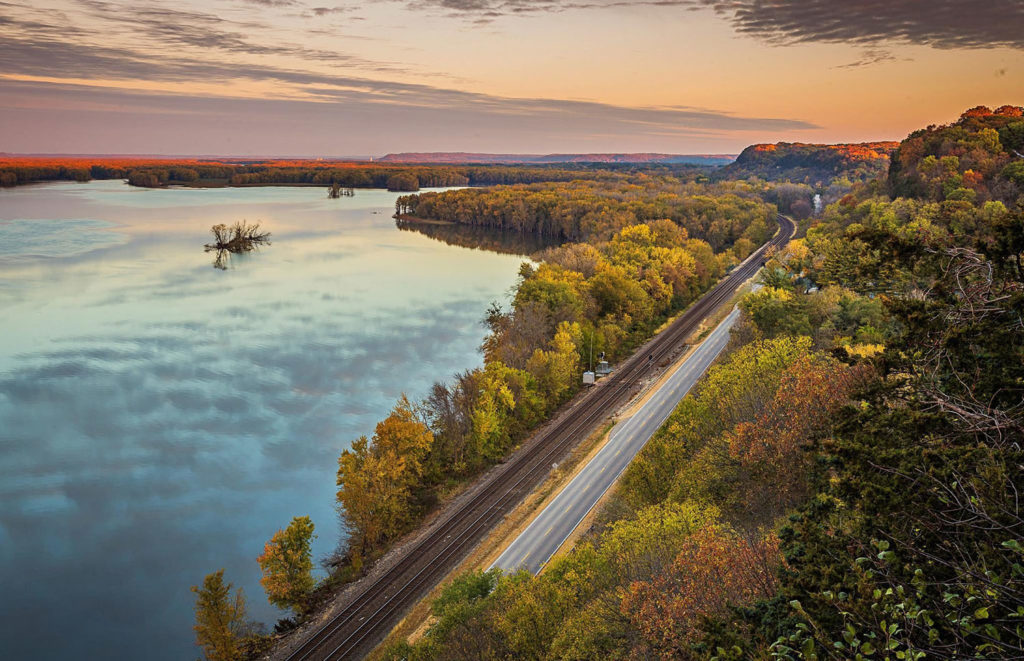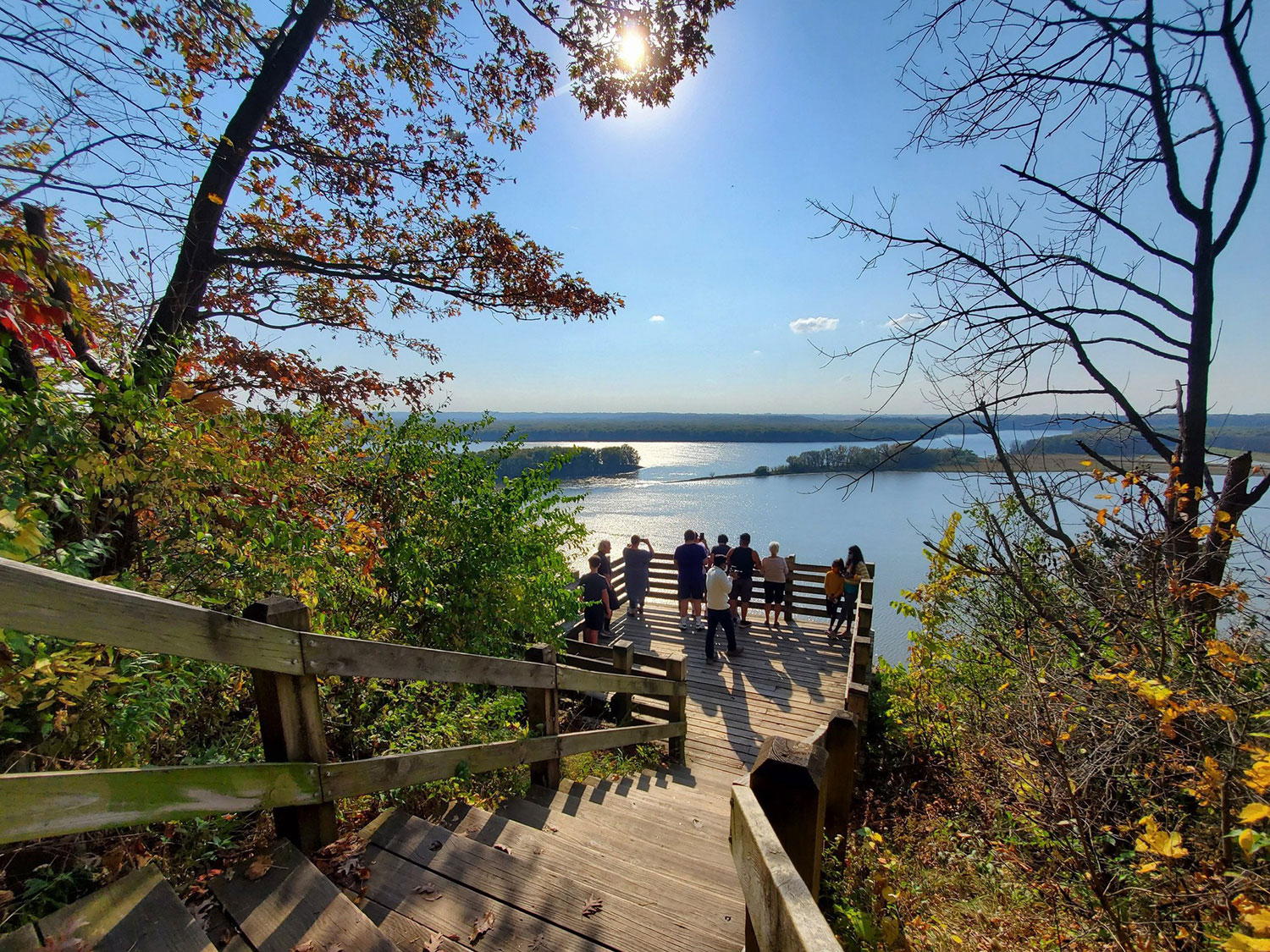It is an underappreciated fact that Illinois has more Mississippi River than any other state: 575 miles from East Dubuque to Cairo. Underappreciated because the river does not play a large role in our state’s identity, as it does in Minnesota, or Missouri, or Tennessee, or Louisiana, or — of course — Mississippi. Most of the state’s people are clustered around Lake Michigan. Our largest river city is Moline, population 41,902. Here in Illinois, the Mississippi is, quite literally, a backwater.
Even authors who wrote about the Mississippi haven’t paid much attention to the state it touches most. In Life on the Mississippi, Mark Twain briefly mentions Chester, as the site of the penitentiary. Of Cairo, he wrote in 1883 that it “has a heavy railroad and river trade, and her situation at the junction of the two great rivers is so advantageous that she cannot well help prospering.” (That did not turn out to be the case.)
In 1979, English travel author Jonathan Raban took a boat trip down the Mississippi, from Minneapolis to the Gulf of Mexico, reporting his journey in the book Old Glory. Raban made landfall in three small Illinois towns: Galena, Nauvoo, and Dallas City. He spent a lot more time in St. Louis.
Probably you don’t have a boat, as Raban did. Illinois’s length of the Mississippi is worth a drive, though, along what the state’s department of tourism calls the Great River Road. Galena, 160 miles northwest of Chicago, is the place to start. As Raban wrote, Galena had been “the victim of a whole series of booms and crashes.” After the lead mines gave out, and the railroad passed it by, “Chicago decorators and architects restored the town and turned it into a museum piece for tourists, a handsomely painted exhibition of Illinois-Queen Anne, Illinois-Romanesque, Illinois-Second Empire, Illinois-Italian Villa, Illinois-Gothic and Illinois-Doric.”
Those decorators and architects did such a convincing job that in the movie Field of Dreams, Galena stood in for Chisholm, Minnesota, the stuck-in-the-19th Century town where Ray Kinsella and Terrance Mann hunt down Moonlight Graham. Galena was also where Ulysses S. Grant began his rise from obscurity to the presidency. In 1861, having been cashiered from the Army for drunkenness, and failed at farming, he was working as a clerk in his father’s leather goods store. Once the Civil War broke out, his military experience allowed him to re-enter the service as a colonel. After Appomattox, the people of Galena gave him an Italianate brick house as a gift. He rarely occupied it, but it has been preserved as a historic attraction. Galena deserves to brag about its connection to a president, even if he was a failure when he lived there.
In Savanna, along Illinois Highway 84, is Mississippi Palisades State Park, a winding length of riverfront cliffs, caves and rock formations that offer broad views of the river, in both directions, and the flat, forested Iowa shore. As an anonymous author wrote in the WPA Guide to Illinois, “Its sheer bluffs, weather-worn crags and densely wooded areas bring to mind the Palisades of the Hudson, for which the park is named. In summer the valleys and slopes are brightened with a mosaic of violets, bluebells, lobelias, bellworts and wild geraniums.”
In the Quad Cities are two still-working projects of the Works Progress Administration, the federal agency that rebuilt the nation and provided jobs to the unemployed during the Great Depression. The 208-acre Black Hawk State Historic Site is a wooded nesting ground for eagles on the banks of the Rock River. Workers logged the wood for the beams in Bell’s Woods, eight miles south of the camp. They mined the limestone themselves, in LeClaire, Iowa. They built trails, stairs, and picnic shelters still used by hikers and birdwatchers. The lodge itself is a popular site for wedding receptions, and also contains the Hauberg Museum, which displays artifacts that belonged to the Sauk and Meskwaki, who once used this site as a lookout.
“It’s nice to have this here in the middle of the Quad Cities,” says Scott Roman, who manages the site for the Illinois Department of Natural Resources. “We’re no Rocky Mountains, but you can take a hike here and see 92 species of birds, deer, wild turkeys, river otters.”
On Arsenal Island is a visitor center and viewing platform for Lock and Dam 15. The 600-foot-long lock, which opened in 1934, can only accommodate nine barges at a time — a standard-sized train in that era of less-powerful tow boats. A 15-barge train has to decouple, and lock through in two steps, pulled along by an automated wire system known as a “mule,” after the animals that once performed that function. It’s a process that can take over two hours. During the fall harvest season, 12 to 15 trains pass through Lock 15 every day, which can cause backups on the river. Barge operators like to boast that theirs is the most cost-effective and environmentally friendly form of transportation. A single barge can hold 62,492 bushels of corn — as much as 16 rail cars or 70 tractor trailers.

Quincy was the site of the sixth Lincoln-Douglas debate, commemorated by a Lorado Taft bas relief in Washington Park. The city has four historic districts, containing examples of just about every architectural style popular in the late 19th and early 20th centuries: Queen Anne, Romanesque, Italianate, Second Empire — legacies of the steamboat era, when Quincy was the state’s second largest city, shipping locally built plows, stoves, wagons and steam engines down the river. The most extraordinary relic is the Villa Kathrine, an Illinois-Moorish mansion built in 1900 by local eccentric George Metz, who traveled the world in search of the perfect home — and found it at the Villa Ben Ahben, in Algiers. Metz’s reproduction of Arabic architecture includes minarets, mosaic floors, an indoor pool, and arched entrances. Metz sold his home in 1912, living the rest of his life in Quincy hotel rooms, but it was restored from decrepitude in the 1970s, and is now open for $3 tours.
Alton was another Lincoln-Douglas debate site, but prefers now to be known as the “Birthplace of Cool,” after native son Miles Davis, whose statue can be found on 3rd Street. On College Avenue is a life-sized statue of Robert Wadlow, the tallest man who ever lived, who grew to 8 feet 11 inches tall before dying at age 22. On Primary Night, as Gov. J.B. Pritzker boasted about Illinois’s history as a progressive state, he mentioned Elijah Lovejoy, Alton’s abolitionist printer, who was lynched by a pro-slavery mob in 1837. Sixty years later, Alton built a 110-foot-tall monument to Lovejoy on a bluff overlooking the river.
If you visit Prairie du Rocher, try to do so on New Year’s Eve. Prairie du Rocher was once an outpost of a French colonial empire that formed a great crescent from Quebec to New Orleans — still represented by Fort de Chartes. “As late as 1900 French was still spoken extensively in Prairie du Rocher,” notes the WPA Guide. One remnant of French culture remains: La Guiannee, an ancient French caroling festival which has been celebrated every December 31 since the village was founded in 1722 — three centuries now. Dressed in old Gallic bonnets and cloaks, the carolers go door to door, singing and fiddling an old French begging song — and usually receiving a warming drink as a reward.
There was a real Popeye the Sailor Man. His name was Frank “Rocky” Fiegel, and he lived in Chester, the hometown of Elzie Crisler Segal, who grew up to become a world-famous cartoonist. Fiegel was a bartender, not a sailor, but he had a jutting jaw, smoked a corncob pipe, and was always eager for a fistfight — all features that Segal reproduced when he sat down to draw Popeye. Segal based characters on other Chester eccentrics: Tall, gaunt Dora Paskel, the general store owner who wore her hair in a bun, became Olive Oyl. J. William Schuchert, the hamburger-loving theater owner, was Wimpy. Today, their statues are all over Chester, which also has a Popeye Museum, inside a store called Spinach Can Collectibles, and Popeye’s Picnic, on the weekend after Labor Day.
Cairo is the end of the journey: the state’s southernmost settlement, it lies at the tip of a peninsula where the Mississippi meets the Ohio, and is protected from both rivers by tall levees. When Charles Dickens visited Cairo in 1842, he called it “a spot so much more desolate than any we had yet beheld, that the forlornest places we had passed, were, in comparison with it, full of interest.” Desolate may also be an appropriate description of modern Cairo, whose population has fallen from 15,000 in the mid-20th century to 1,884 today, as a consequence of declining river traffic and racial conflict. “There is no grocery store,” the St. Louis Post-Dispatch wrote of Cairo. “No hospital. No community center, so the high school gym hosts weddings and post-funeral meals and pickup basketball.” There is, though, Magnolia Manor, a fourteen-room mansion built by a 19th Century flour magnate, and open to tourists who want to relive Cairo’s glory days. Down at the tip of the peninsula is a monument to Lewis and Clark, whose expedition camped in Cairo on November 14, 1803. After that, there’s no more Illinois. We hand off the Mississippi River to Kentucky, which, really, doesn’t do nearly as much with it.
Related Content



